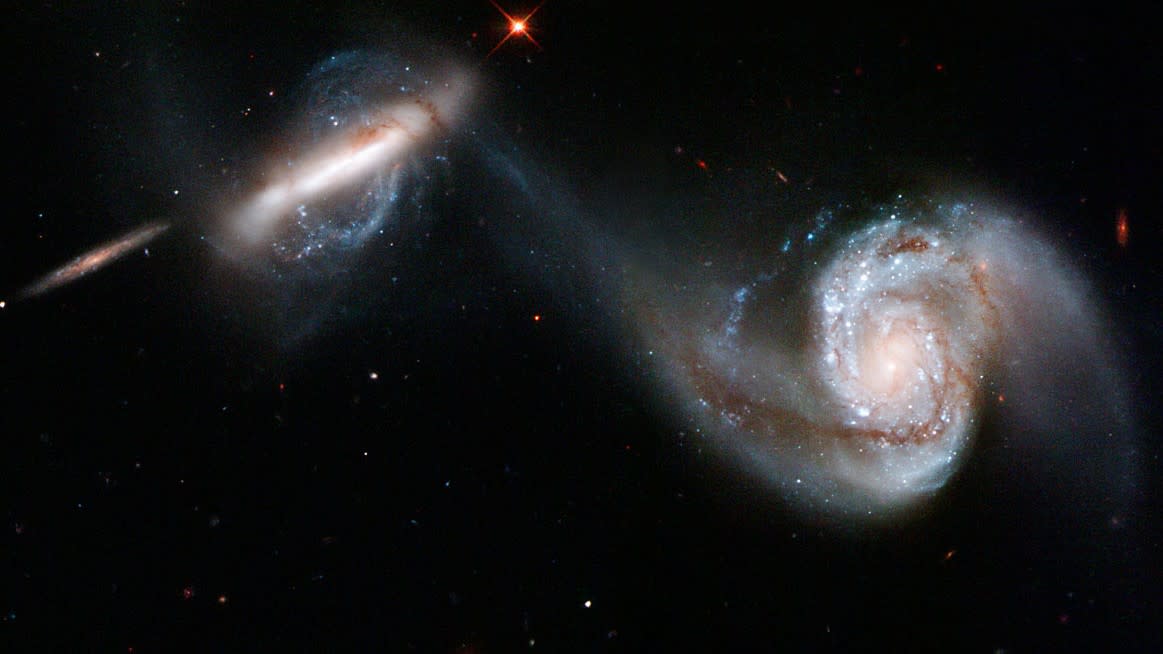Galactic collisions act as a 'cosmic delivery service' for hungry monster black holes

Scientists have long thought that when galaxies collide, the violent process delivers gas that feeds supermassive black holes and acts as fuel for energetic outbursts. Now, astronomers have obtained the first evidence to support the existence of this "cosmic delivery service."
The revelation demonstrates an important link between violent interactions with neighboring galaxies and the tremendous volumes of gas needed to fuel these monstrous black holes, which are thought to dwell at the hearts of most large galaxies.
The discovery could finally reveal how supermassive black holes get enough fuel to power the intense activity that can light up the hearts of their home galaxies. Feeding supermassive black holes that power energetic outbursts are called active black holes, and the regions they dwell in are known as active galactic nuclei (AGN).
Related: Black holes at galactic centers blast out 10 times more light than previously thought
"Supermassive black holes fuel their activity by, in part, the gradual accumulation of gas from the environment around them," Sandra Raimundo, an astronomer at the University of Southampton in the U.K. who led the research, said in a statement. "Supermassive black holes can make the centers of galaxies shine very brightly when they capture gas, and it's thought this process can be a major influence on the way that galaxies look today.
"How supermassive black holes get enough fuel to sustain their activity and growth still puzzles astronomers, but the work we have carried out provides a step towards understanding this," she added.
Raimundo's team, which included researchers at the University of California, Los Angeles and the University of Copenhagen, tackled this mystery by using the Anglo-Australian Telescope in Australia to study the orbits of gas and stars in over 3,000 galaxies.
This allowed them to detect gas rotating in the opposite direction as the stars in some of the galaxies. This "misaligned" gas indicates an interaction, such as a collision and merger, between those galaxies and other galaxies in the past.
Galaxies with misaligned gas were also more likely to feature an active supermassive black hole. This link between misaligned gas and active supermassive black holes hinted that the collision and merger of galaxies may deliver gas to where the galaxies meet.
This gas then travels vast distances before encountering the massive gravitational influence of the supermassive black hole. Dragged toward the cosmic titan, the gas then ends its journey by being swallowed by the black hole and acting as a fuel source for AGN activity, the researchers explained.
"The work that we carried out shows the presence of gas that is misaligned from stars is associated with an increase in the fraction of active supermassive black holes," Raimundo said. "Since misaligned gas is a clear sign of a past interaction between two galaxies, our work shows that galaxy interactions provide fuel to power active supermassive black holes."
This gas-delivery mechanism has been suspected for a long time, but this is the first observational evidence of galactic collisions acting as a "cosmic delivery service" feeding supermassive black holes.
Related stories:
— Fastest-growing black hole ever seen is devouring the equivalent of 1 Earth per second
— Supermassive black holes could host giant, swirling gas 'tsunamis'
— The Milky Way's supermassive black hole is leaking gas
"What is exciting about these observations is that we can now, for the very first time, identify the captured gas and trace it all the way to the center where the black hole is devouring it," study co-author Marianne Vestergaard, a professor at the University of Copenhagen's Niels Bohr Institute, said in the statement.
Next, the team will use the findings to investigate how much of the supermassive black hole's mass grew as a result of this feeding mechanism and the role this process has played in the evolution of galaxies.
The research was published Jan. 19 in the journal Nature Astronomy.
Follow us on Twitter @Spacedotcom or on Facebook.

